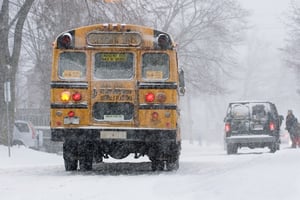School Bus Maintenance Winter Challenges
published on January 15, 2016 by Sonia Mastros
school bus management, school bus safety, school bus maintenance, school bus fleet
 School buses are often exposed to extreme conditions, and the winter months can be particularly hard on your fleet. The addition of ice, snow and chilly weather to an already strained bus can lead to tire slippage, engine trouble and rust. Winter weather can expose the weaknesses in your fleet, and when the air gets chilly, school bus maintenance issues usually spring to life.
School buses are often exposed to extreme conditions, and the winter months can be particularly hard on your fleet. The addition of ice, snow and chilly weather to an already strained bus can lead to tire slippage, engine trouble and rust. Winter weather can expose the weaknesses in your fleet, and when the air gets chilly, school bus maintenance issues usually spring to life.
Of course, developing a year-round maintenance plan that can be easily adjusted when winter rolls around is the best bet for keeping students and drivers safe, but there are several things that you can do to make the cold months easier if a system is not already in place.
Tires
Tires should be inspected on a regular basis, but this task becomes urgent during the winter months. Especially if buses are exposed to snow and ice, tread issues can lead to dangerous slipping. Some districts utilize snow tires year round, while others make a switch during snowy months. While this is not a necessity for all districts, tires should be customized based on their route and the potential for danger.
Routes
Routes that work well during the warm summer months are not always the best choice for the harsh chill of winter. In some areas, routing should be adjusted to ensure passenger and driver safety. Steep inclines, narrow roads and snow piles are just a few of the hazards that should be avoided. Optimizing routes for winter safety might sound complicated, but today's state-of-the-art scheduling software makes choosing the right routes easier than it's ever been.
Regular inspections
During the winter months, it is important to check certain systems for safety and comfort on a regular basis. Heating and defrosting units should be inspected thoroughly and consistently, along with hoses, fan belts and electrical wiring. Batteries should be kept fully charged and warm and fuel tanks kept as full as possible to keep condensation from forming on the tank walls. New wiper blades should be installed at the beginning of winter and all window and windshield glass inspected for any cracks.
For more information on preparing your bus fleet for the winter months and optimizing your routes for cold-weather safety, contact one of our transportation experts.
How do you prepare your school bus fleet for the chilly weather of winter? We’d love to hear from you.






